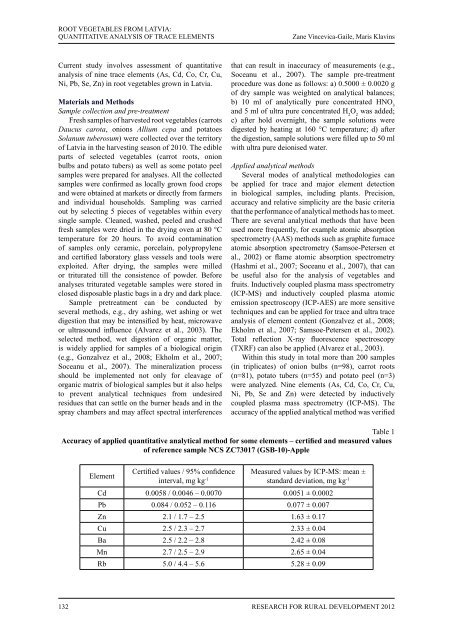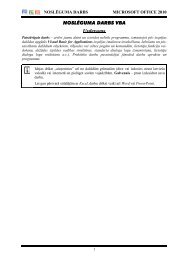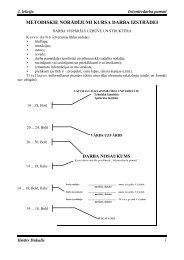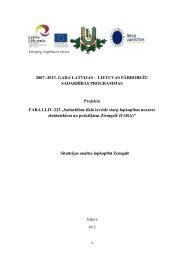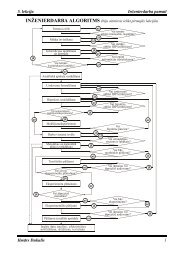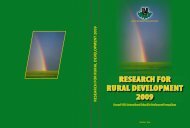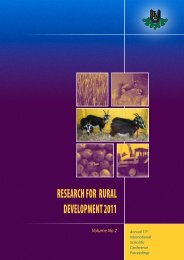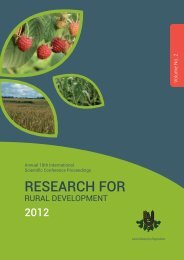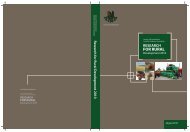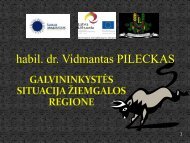FOOD SCIENCESZane Vincevica-Gaile, Maris KlavinsUniversity of Latviae-mail: zane.gaile@lu.lvROOT VEGETABLES FROM <strong>LATVIA</strong>:QUANTITATIVE ANALYSIS <strong>OF</strong> TRACE ELEMENTSAbstractFood and drinking water are the main sources of trace and major elements. Besides the elements that are vitally essentialfor living organisms and human health, food may contain the traces of potentially toxic elements. Environmental sitespecific impact is one of the influencing factors of elemental content in plants that is important issue also for qualityof food crops. Quantitative content of several trace elements (e.g., Al, As, Cd, Co, Cr, Cu, Ni, Pb, Zn) detected in foodcrops reveal environmental background levels as well as it can be associated with unexpected food contamination.Current study involves quantitative analysis of more than 200 root vegetable samples (onions, carrots and potatoes)grown and collected in Latvia in the harvesting season of 2010. Within this study the quantitative analysis of vegetablesfor 9 elements (As, Cd, Co, Cr, Cu, Ni, Pb, Se, Zn) was performed. After the wet digestion of samples, the quantitativeanalysis was done by using inductively coupled plasma mass spectrometry (ICP-MS). Obtained results revealed wideranges of trace elements in root vegetables, including potentially toxic elements. Comparison of element content inedible parts of vegetables and potato peel showed that a great part of elements (e.g., As, Co, Cr, Pb) is concentratedin peel; however, some elements (e.g., Cd, Se, Zn) are taken up by plants, and therefore may contaminate food moreeasily. Element transfer routes and their biochemistry is a complicated issue that is affected by natural environmentalfactors as well as by anthropogenic activities.Key words: environmental impact; ICP-MS; potentially toxic elements; quantitative analysis; root vegetables; traceelements.IntroductionTrace and major elements are the basic constituentsof many chemical, biochemical and enzymaticreactions, biological and physiological as well ascatabolic and metabolic processes of living organisms.Drinking water and food or feed are the main sourcesof chemical elements. Besides the elements that arevitally essential for human health, food may containthe traces of elements such as As, Cd, Co, Cr, Hg,Pb, Zn etc. from which several can be estimated aspotentially toxic elements (Jawad, 2010; Hashmi etal., 2007).Environmental site specific impacts, particularly,soil and water chemical composition are among themain influencing factors of the elemental content.That is important issue of quality and chemical safetyof agricultural and horticultural crops. Quantitativecontent of trace elements detected in food crops revealenvironmental background levels as well as it canbe associated with unexpected food contamination.Contamination of plants and their edible parts bypotentially toxic metals in great extent may becaused by anthropogenic activities such as the use ofagrochemicals and fertilizers, industrial and trafficintensity, use of fossil fuels for domestic needs orindustry, as well as harvesting, storage and processingspecifics (Matos-Reyes et al., 2010; Ekholm et al.,2007; Radwan and Salama, 2006). Potentially toxicelements, widely known also as heavy metals, are notbiodegradable and their deposition and accumulationin soils primarily may affect the quality of vegetablesand fruits grown in contaminated or polluted areas.Some elements such as Cd, Hg and Pb are toxic forliving organisms even in very small concentrations,while other elements (e.g. Cr, Fe, Mn, Ni, Se, Zn)are essential in certain amounts but may becomepotentially harmful if consumed frequently in amountsabove the preferable daily concentrations, and alsocan accumulate in plants, including edible parts ofvegetables, consequently leading the contaminationof food chain plant-animal-human or plant-human(Jawad, 2010; Zheng et al., 2007). For example,continuous intake of such elements as cadmium or leadmay result in chronic toxicity, damage of vital organsand irreversible accumulation of these elements inorgans and tissues (liver, kidney, fat) (Hashmi et al.,2007; Kumar et al., 2007).The presence of essential trace elements (e.g., Co,Cr, Cu, Fe, Mg, Mn, Ni, Zn), as well as potentiallytoxic elements (e.g., Al, As, Cd, Pb) in fruits andvegetables has been investigated widely around theworld (Mohamed et al., 2003), however, the elementcomposition of plants depends on local natural andenvironmental factors, and in Northern Europe it is apoorly studied issue.The aim of the research was to study theenvironmental impact and possible pollution levelswith potentially toxic elements in food. Latvia, arelatively small country in the North-East of Europe,was set as the target area for this study due to theabsence of large pollution sources and low industrialand agricultural activities within the territory of thecountry that allows to estimate the environmentalbackground of elements in locally produced food.Research for Rural Development 2012131
ROOT VEGETABLES FROM <strong>LATVIA</strong>:QUANTITATIVE ANALYSIS <strong>OF</strong> TRACE ELEMENTSZane Vincevica-Gaile, Maris KlavinsCurrent study involves assessment of quantitativeanalysis of nine trace elements (As, Cd, Co, Cr, Cu,Ni, Pb, Se, Zn) in root vegetables grown in Latvia.Materials and MethodsSample collection and pre-treatmentFresh samples of harvested root vegetables (carrotsDaucus carota, onions Allium cepa and potatoesSolanum tuberosum) were collected over the territoryof Latvia in the harvesting season of 2010. The edibleparts of selected vegetables (carrot roots, onionbulbs and potato tubers) as well as some potato peelsamples were prepared for analyses. All the collectedsamples were confirmed as locally grown food cropsand were obtained at markets or directly from farmersand individual households. Sampling was carriedout by selecting 5 pieces of vegetables within everysingle sample. Cleaned, washed, peeled and crushedfresh samples were dried in the drying oven at 80 °Ctemperature for 20 hours. To avoid contaminationof samples only ceramic, porcelain, polypropyleneand certified laboratory glass vessels and tools wereexploited. After drying, the samples were milledor triturated till the consistence of powder. Beforeanalyses triturated vegetable samples were stored inclosed disposable plastic bags in a dry and dark place.Sample pretreatment can be conducted byseveral methods, e.g., dry ashing, wet ashing or wetdigestion that may be intensified by heat, microwaveor ultrasound influence (Alvarez et al., 2003). Theselected method, wet digestion of organic matter,is widely applied for samples of a biological origin(e.g., Gonzalvez et al., 2008; Ekholm et al., 2007;Soceanu et al., 2007). The mineralization processshould be implemented not only for cleavage oforganic matrix of biological samples but it also helpsto prevent analytical techniques from undesiredresidues that can settle on the burner heads and in thespray chambers and may affect spectral interferencesthat can result in inaccuracy of measurements (e.g.,Soceanu et al., 2007). The sample pre-treatmentprocedure was done as follows: a) 0.5000 ± 0.0020 gof dry sample was weighted on analytical balances;b) 10 ml of analytically pure concentrated HNO 3and 5 ml of ultra pure concentrated H 2O 2was added;c) after hold overnight, the sample solutions weredigested by heating at 160 °C temperature; d) afterthe digestion, sample solutions were filled up to 50 mlwith ultra pure deionised water.Applied analytical methodsSeveral modes of analytical methodologies canbe applied for trace and major element detectionin biological samples, including plants. Precision,accuracy and relative simplicity are the basic criteriathat the performance of analytical methods has to meet.There are several analytical methods that have beenused more frequently, for example atomic absorptionspectrometry (AAS) methods such as graphite furnaceatomic absorption spectrometry (Samsoe-Petersen etal., 2002) or flame atomic absorption spectrometry(Hashmi et al., 2007; Soceanu et al., 2007), that canbe useful also for the analysis of vegetables andfruits. Inductively coupled plasma mass spectrometry(ICP-MS) and inductively coupled plasma atomicemission spectroscopy (ICP-AES) are more sensitivetechniques and can be applied for trace and ultra traceanalysis of element content (Gonzalvez et al., 2008;Ekholm et al., 2007; Samsoe-Petersen et al., 2002).Total reflection X-ray fluorescence spectroscopy(TXRF) can also be applied (Alvarez et al., 2003).Within this study in total more than 200 samples(in triplicates) of onion bulbs (n=98), carrot roots(n=81), potato tubers (n=55) and potato peel (n=3)were analyzed. Nine elements (As, Cd, Co, Cr, Cu,Ni, Pb, Se and Zn) were detected by inductivelycoupled plasma mass spectrometry (ICP-MS). Theaccuracy of the applied analytical method was verifiedTable 1Accuracy of applied quantitative analytical method for some elements – certified and measured valuesof reference sample NCS ZC73017 (GSB-10)-AppleElementCertified values / 95% confidence Measured values by ICP-MS: mean ±interval, mg kg -1 standard deviation, mg kg -1Cd 0.0058 / 0.0046 – 0.0070 0.0051 ± 0.0002Pb 0.084 / 0.052 – 0.116 0.077 ± 0.007Zn 2.1 / 1.7 – 2.5 1.63 ± 0.17Cu 2.5 / 2.3 – 2.7 2.33 ± 0.04Ba 2.5 / 2.2 – 2.8 2.42 ± 0.08Mn 2.7 / 2.5 – 2.9 2.65 ± 0.04Rb 5.0 / 4.4 – 5.6 5.28 ± 0.09132 Research for Rural Development 2012


